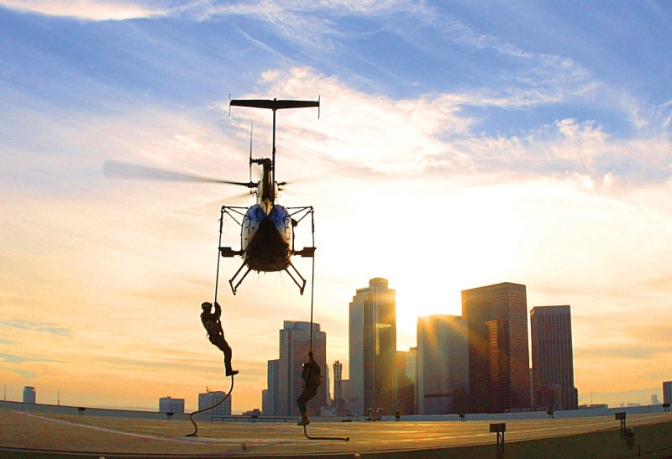We’ve all heard of the 160th Special Operations Aviation Regiment of the United States Army- the legendary Night Stalkers, who are tasked with providing aerial insertions and extractions for some of the most elite special operations outfits in existence. The Army’s Delta Force, the Navy’s DEVGRU (formerly known as SEAL Team 6), and many more. But, as it turns out, there’s yet another spec ops aviation unit, just as crazy and skillful as the Night Stalkers.
Known as the Tactical Helicopter Unit (THU), it’s attached to the Federal Bureau of Investigation’s Hostage Rescue Team (HRT), another elite counterterrorism unit in itself. The HRT is composed of “operators”, the final product of a gruelling selection course identical to that which the Army puts prospective Delta Force operators through. After passing selection, candidates are sent through yet another course known as New Operators Training Course (NOTS), also identical to Delta Force’s Operators Training Course. Each selectee can expect to expend thousands of rounds of ammunition weekly from there on out, maintaining a rigorous fitness regimen and constant instruction in various disciplines and fields relevant to the successful execution of counterterrorism operations.
By the end of it all, those who are given the coveted HRT patch are able to carry out some of the most extraordinarily dangerous missions, including mitigating terror threats, raiding and securing hijacked ships and aircraft, etc. HRT operators are sent through military schools as well, including the Marine Corps’ famed scout/sniper course. They also cross-train with other elite units from around the world, such as the British Special Air Service (SAS) and the French National Gendarmerie Intervention Group (GIGN). Able to deploy to anywhere in the United State (and its protectorates) within four hours or less upon activation, the HRT’s primary mission is described best by its motto- Servare Vitas, Latin for “to save lives”.
And in saving lives, nothing less than the best will do, which is why HRT operators train as hard as they do. It’s also why only the most well-trained, cool-headed and top-notch rotary aviators around are allowed to try out for and serve in the THU, supporting the HRT from the air.
Thanks to their vital and unique mission, THU aviators are trained on an array of helos, including converted UH-60 Black Hawks, Bell 412EP and 407s, and the MD 530, the civilian variant of the MH-6 Little Bird, currently in use with the Army’s 160th SOAR(A)’s Night Stalkers. Pilots are trained special agents and often enter with former military experience, even some still who’ve served as Night Stalkers before joining the Bureau. Trained and equipped to fly in all weather conditions, rain, shine or even some weird mixture of the two (read: typical Cleveland, OH weather), THU aviators fly daily to stay current and ready to support HRT operators whenever the call comes. Since the THU’s helos don’t have considerable ferry ranges, though they’re expected to be able to be ready to rock in any part of the country should the need arise, the US Air Force provides an airlift and transport capability with its C-17 Globemaster IIIs, C-5M Super Galaxies or C-130H/J Hercules/Super Hercules cargo planes to bring the helicopters and their pilots wherever the Bureau wants them.
THU aviators are trained to be able to fly safely and efficiently in spaces tighter than the average rotary pilot would normal fly in (i.e. urban areas for example), and can typically deploy operators from outboard benches on the MD 530 or Bell 507 into small, cramped landing zones, similar to what the Night Stalkers are able to do with their Little Birds. If rotor clearance is lacking (meaning that the pilots can’t touch down safely without the radius of their blades intersecting with foreign objects), the THU’s helos are also able to make use of fast-roping, which involves hanging a thick cable from the sides of the helicopter which operators slide down. Since the nature of their job calls for them to be able to fly in a number of varying environments, THU aviators are also trained to fly out at sea, supporting HRT air assaults on hijacked vessels. On top of that, they’re also able to use their helos to support raids on grounded hijacked airliners, as is evidenced by the photograph below.



Paragraphs help us, the reader, be able to follow your article. Long 25 – 50 sentence paragraphs make it near impossible to read.
LikeLike
Reblogged this on Notes from the Green Dragon Tavern.
LikeLike
I TSHAMAKA KAMBILU RESIDING AT 156 ELSTON WITH SOB NO J025 AND ID NO BRA/000956/02 AM MEMBER OF MUSAD,CIA AND WORKER OF FBI.
LikeLiked by 1 person
Oh it looks like you are one of those terrorists that works for the CIA and FBI…
http://www.targetedjustice.com
Because those organizations are the ones who are the terrorists.
LikeLike
The FBI is corrupt, stop putting this bullshit on the internet.
LikeLike
http://www.targetedjustice.com
The FBI are nervous little cowards.
LikeLike
I think it’s funny that the general public thinks that the FBI are baddasses… ROTFLMFAO!!!!!
They are mentally ill Sociopathic cowards.
http://www.targetedjustice.com
LikeLike